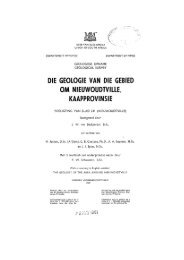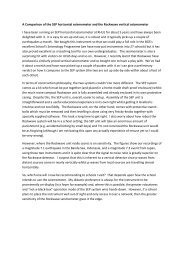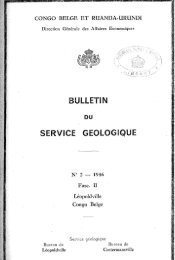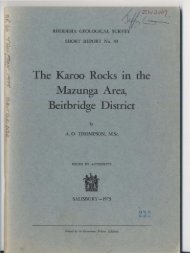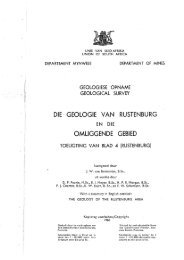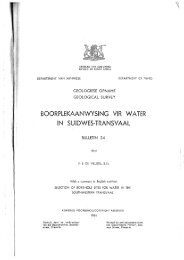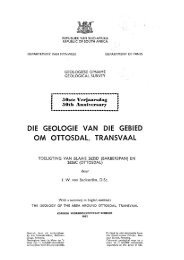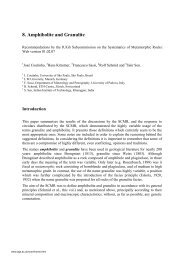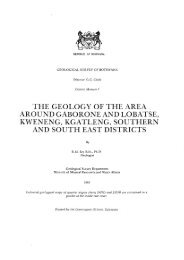Bibliography - British Geological Survey
Bibliography - British Geological Survey
Bibliography - British Geological Survey
Create successful ePaper yourself
Turn your PDF publications into a flip-book with our unique Google optimized e-Paper software.
Weinert, H. 1958. Zum Abschluß des Piltdown-Problems. Zeitschrift fürMorphologie und Anthropologie,<br />
49 (1), 55–60. (Weiner was at first reluctant to accept the initial findings of the investigation into the<br />
Piltdown forgery, but acquiesced after the full report appeared in 1955. He had examined the original finds<br />
at the Natural History Museum in 1932, and at the time had suspected that the bones from Piltdown I and II<br />
may have become mixed up.)<br />
Werner, A. E. A. & Plesters, R. J. 1955. The black coating on the Piltdown canine. In: Further<br />
contributions to the solution of the Piltdown problem / J. S. Weiner et al. Bulletin of the <strong>British</strong> Museum<br />
(Natural History), Geology, 2 (6), 271–272.<br />
Werth, E. 1916. Die Auflösung des Eoanthropus Dawsoni. Zeitschrift für Ethnologie, 48, 261–264.<br />
(Attributes the Piltdown finds to Pan vetus and Homo Dawsoni)<br />
Werth, E. 1919. Das Problem des tertiären Menschen. Sitzungsberichte der Gesellschaft Naturforschender<br />
Freunde zu Berlin, Jahrgang 1918, 1‒32. (Eoanthropus, pp. 21‒26)<br />
Werth, E. 1928. Der fossile Mensch: Grundzüge einer Paläanthropologie. Berlin: Borntraeger, 898 pp.<br />
(Eoanthropus, pp. 803‒808)<br />
White, H. J. O. 1926. The geology of the country near Lewes. London: HMSO, Memoirs of the <strong>Geological</strong><br />
<strong>Survey</strong>, England, explanation of sheet 319. (Description of the Ouse valley terrace gravels at Piltdown and<br />
Barkham, pp. 63–70, with a geological cross section provided by F. H. Edmunds, fig. 10; the gravel terrace<br />
is here shown to be only 50 ft above the present level of the River Ouse, not 80ft as previously argued by<br />
Dawson. Includes remarks communicated by A. Smith Woodward concerning an undescribed ‘thick and<br />
well-mineralized human skull of modern type’ found by Dawson ‘in the fields... just above Barcombe Mills<br />
Station’ [i.e. Piltdown III], and quotes a letter from the same source respecting the location of the second<br />
Piltdown site.)<br />
Whittaker, J. 2005. Bits of bogus science preceding Piltdown. Skeptical Inquirer, 29 (1), 50‒51.<br />
Williams, J. L. 1913. [Article on Piltdown remains]. Scientific American, Dec. (Cited by Spencer 1990b.<br />
Dr J. Leon Williams, an American dentist, visited England in June 1913, and appears to have been working<br />
on the Piltdown problem with Arthur Keith (Spencer 1990b, 70, 77, 81). Williams made a (cinematic?) film<br />
of the excavations at Piltdown, now believed lost (Spencer 1990b, 73), from which a much-reproduced image<br />
has been preserved showing Woodward, Dawson and Venus Hargreaves screening gravel at Piltdown, first<br />
published by Osborn 1922.)<br />
Wilson, A. 1956. Anglo-Saxon attitudes. London: Secker & Warburg, 412 pp. (A novel, in which the<br />
essential storyline revolves around the recently exposed Piltdown forgery. Thus, the character of Professor<br />
Middleton suspects an archaeological hoax of a similar kind committed forty years earlier by his friends and<br />
colleagues, but he says nothing, and must live with his conscience. Wilson also published, in 1981, a paper<br />
entitled ‘The genesis of Anglo-Saxon attitudes’ avail at: http://www.lib.uiowa.edu/spec-coll/bai/anglo.html )<br />
Winslow, J. H. & Meyer, A. 1983a. The perpetrator at Piltdown. Science 83, 4 (7) Sept, 32‒43, editorial 5.<br />
(An absurd piece of sensationalism that accuses Sir Arthur Conan Doyle of perpetrating the Piltdown fraud.<br />
The evidence is circumstantial and trivial, and quite insufficient to support an argument that does little credit<br />
to either author. For reactions to this paper see Cox 1983, Gould 1983b, Moriarty 1983, Langham 1984,<br />
Doyle & Costello 1987, Elliott 1988; other responses are listed in Turrittin 2006, 19.)<br />
Winslow, J. H. & Meyer, A. 1983b. Piltdown debate: not so elementary. Science 83, 4 (9), 23–24. (Reply<br />
to criticisms from Don Richard Cox and Stephen Jay Gould)<br />
Winton, W. 1956. The Piltdown clock. The <strong>British</strong> Steelmaker, Oct, 292‒293. (The Ashburnham brass<br />
clock dial, an engraved piece ‘apparently’ of the seventeenth century, had once been in the collection of<br />
Charles Dawson. While the clock plate appears to be of early 19th century date, the engraving could be late<br />
19th or early 20th century. See Combridge 1977, Russell 2003, 144–148.)<br />
Woodward, A. S. 1892. On a mammalian tooth from the Wealden Formation at Hastings. Proceedings of<br />
the Zoological Society of London, for 1891, 24 (4), 585–586. (Received 17 Nov 1891; published 1 Apr<br />
1892. Stated as having been discovered by Charles Dawson in an irregular bone-bed in the Wadhurst Clay.<br />
Woodward pronounced this molar tooth to be ‘the first evidence of a European Cretaceous Mammal’, and<br />
provisionally named it as a new species, Plagiaulax dawsoni. He notes the ‘extraordinary amount of wear to<br />
which the crown has been subjected’. Mammals belonging to the genus Plagiaulax had already been found



